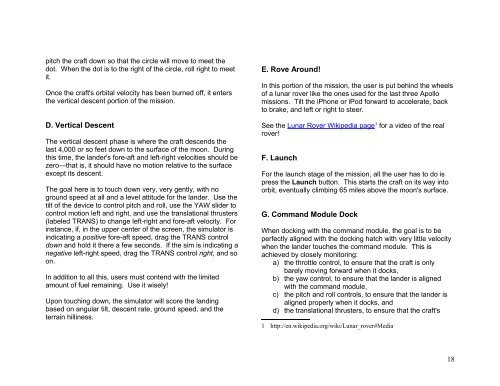Space Shuttle and Apollo manual - X-Plane.com
Space Shuttle and Apollo manual - X-Plane.com
Space Shuttle and Apollo manual - X-Plane.com
You also want an ePaper? Increase the reach of your titles
YUMPU automatically turns print PDFs into web optimized ePapers that Google loves.
pitch the craft down so that the circle will move to meet the<br />
dot. When the dot is to the right of the circle, roll right to meet<br />
it.<br />
Once the craft's orbital velocity has been burned off, it enters<br />
the vertical descent portion of the mission.<br />
D. Vertical Descent<br />
The vertical descent phase is where the craft descends the<br />
last 4,000 or so feet down to the surface of the moon. During<br />
this time, the l<strong>and</strong>er's fore-aft <strong>and</strong> left-right velocities should be<br />
zero—that is, it should have no motion relative to the surface<br />
except its descent.<br />
The goal here is to touch down very, very gently, with no<br />
ground speed at all <strong>and</strong> a level attitude for the l<strong>and</strong>er. Use the<br />
tilt of the device to control pitch <strong>and</strong> roll, use the YAW slider to<br />
control motion left <strong>and</strong> right, <strong>and</strong> use the translational thrusters<br />
(labeled TRANS) to change left-right <strong>and</strong> fore-aft velocity. For<br />
instance, if, in the upper center of the screen, the simulator is<br />
indicating a positive fore-aft speed, drag the TRANS control<br />
down <strong>and</strong> hold it there a few seconds. If the sim is indicating a<br />
negative left-right speed, drag the TRANS control right, <strong>and</strong> so<br />
on.<br />
In addition to all this, users must contend with the limited<br />
amount of fuel remaining. Use it wisely!<br />
Upon touching down, the simulator will score the l<strong>and</strong>ing<br />
based on angular tilt, descent rate, ground speed, <strong>and</strong> the<br />
terrain hilliness.<br />
E. Rove Around!<br />
In this portion of the mission, the user is put behind the wheels<br />
of a lunar rover like the ones used for the last three <strong>Apollo</strong><br />
missions. Tilt the iPhone or iPod forward to accelerate, back<br />
to brake, <strong>and</strong> left or right to steer.<br />
See the Lunar Rover Wikipedia page 1 for a video of the real<br />
rover!<br />
F. Launch<br />
For the launch stage of the mission, all the user has to do is<br />
press the Launch button. This starts the craft on its way into<br />
orbit, eventually climbing 65 miles above the moon's surface.<br />
G. Comm<strong>and</strong> Module Dock<br />
When docking with the <strong>com</strong>m<strong>and</strong> module, the goal is to be<br />
perfectly aligned with the docking hatch with very little velocity<br />
when the l<strong>and</strong>er touches the <strong>com</strong>m<strong>and</strong> module. This is<br />
achieved by closely monitoring:<br />
a) the throttle control, to ensure that the craft is only<br />
barely moving forward when it docks,<br />
b) the yaw control, to ensure that the l<strong>and</strong>er is aligned<br />
with the <strong>com</strong>m<strong>and</strong> module,<br />
c) the pitch <strong>and</strong> roll controls, to ensure that the l<strong>and</strong>er is<br />
aligned properly when it docks, <strong>and</strong><br />
d) the translational thrusters, to ensure that the craft's<br />
1 http://en.wikipedia.org/wiki/Lunar_rover#Media<br />
18














